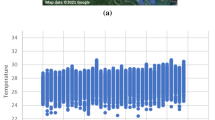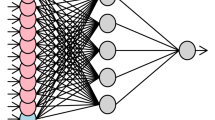Abstract
The aim of this study is to estimate the monthly mean relative humidity (MRH) values in the Aegean Region of Turkey with the help of the topographical and meteorological parameters based on artificial neural network (ANN) approach. The monthly MRH values were calculated from the measurement in the meteorological observing stations established in Izmir, Mugla, Aydin, Denizli, Usak, Manisa, Kutahya and Afyonkarahisar provinces between 2000 and 2006. Latitude, longitude, altitude, precipitation and months of the year were used in the input layer of the ANN network, while the MRH was used in output layer of the network. The ANN model was developed using MATLAB software, and then actual values were compared with those obtained by ANN and multi-linear regression methods. It seemed that the obtained values were in the acceptable error limits. It is concluded that the determination of relative humidity values is possible at any target point of the region where the measurement cannot be performed.








Similar content being viewed by others
References
Akinbode OM, Eludoyin AO, Fashae OA (2008) Temperature and relative humidity distributions in a medium-size administrative town in southwest Nigeria. J Environ Manag 87:95–105
Bilgili M (2010) Prediction of soil temperature using regression and artificial neural network models. Meteorol Atmos Phys 110:59–70
Bilgili M, Sahin B (2010) Comparative analysis of regression and artificial neural network models for wind speed prediction. Meteorol Atmos Phys 109:61–72
Bilgili M, Sahin B, Yasar A (2007) Application of artificial neural networks for the wind speed prediction of target station using reference stations data. Renew Energy 32:2350–2360
Hajat S, Kovats R, Atkinson RW, Harner A (2002) Impact of hot temperatures on death in London: a time series approach. J Epidemiol Community 56:367–372
Haykin S (1994) Neural networks, a comprehensive foundation. Prentice-Hall, Inc, New Jersey
Hitle DC, Pendersen CO (1981) Periodic and stochastic behavior of weather data. ASHRAE Trans 87:173
Kalkstein LS, Greene JS (1997) An evaluation of climate/mortality relationships in large US cities and the possible impacts of a climate change. Environ Health Perspect 105:84–93
Kalogirou SA, Neocleous C, Paschiardis S and Schizas C (1999) Wind speed prediction using artificial neural networks. European Symposium on Intelligent Techniques ESIT’99, Crete (Greece)
Parishwad GV, Bhardwaj RK, Nema VK (1998) Prediction of monthly-mean hourly relative humidity, ambient temperature, and wind velocity for India. Renew Energy 13:363–380
Sagiroglu S, Besdok E, Erler M (2003) Artificial neural network applications in engineering-I: artificial neural network. Ufuk Press, Kayseri
Sozen A, Arcaklioglu E (2005) Effect of relative humidity on solar potential. Appl Energy 82:345–367
TUIK (2010), Turkish Statistical Institute Turkey in Statistics 2010, ISBN 978-975-19-4945-5
Turkish Republic Ministry of Agriculture and Rural Areas, Directorate of Strategy Development, TR3 Aegean Region Agriculture Master Plan, Ankara, 2006
Valverde Ramirez MC, De Campos Velho HF, Ferreira NJ (2005) Artificial neural network technique for rainfall forecasting applied to the Sao Paulo Region. J Hydrol 301:146–162
Yilmaz S, Toy S, Irmak MA, Yilmaz H (2007) Determination of climatic differences in three different land uses in the city of Erzurum, Turkey. Build Environ 42:1604–1612
Acknowledgments
The authors would like to express their appreciation to the Turkish State Meteorological Services (TSMS) for providing the data.
Author information
Authors and Affiliations
Corresponding author
Additional information
Responsible Editor: L. Gimeno.
Rights and permissions
About this article
Cite this article
Yasar, A., Simsek, E., Bilgili, M. et al. Estimation of relative humidity based on artificial neural network approach in the Aegean Region of Turkey. Meteorol Atmos Phys 115, 81–87 (2012). https://doi.org/10.1007/s00703-011-0168-2
Received:
Accepted:
Published:
Issue Date:
DOI: https://doi.org/10.1007/s00703-011-0168-2




